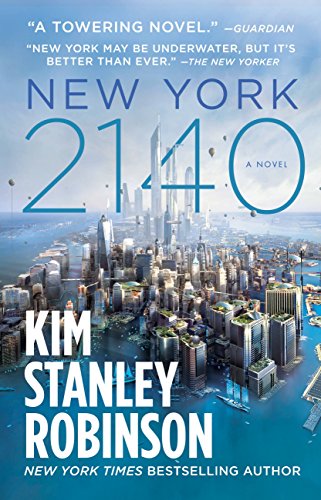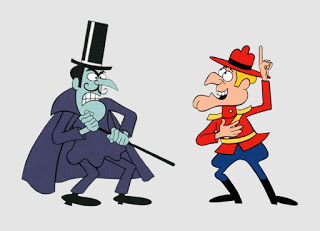[cross-posted at C4SS, BHL, and POT]
Robinson, Kim Stanley. New York 2140. (Orbit Books, 2017).
Kim Stanley Robinson is one of the best science-fiction writers working today. Recurring themes in his stories include ecology, archeological exploration, anti-capitalist politics, and the ineluctable passage of time – all of which feature in New York 2140, which, like much of his work (including Icehenge, The Martians, 2312, Galileo’s Dream, and Aurora) fits almost-but-not-quite into the future history established in the Mars trilogy, his best-known work. (The inconsistencies are explained in Galileo’s Dream, where we learn that these various narratives belong to distinct but closely adjacent timelines.)

New York 2140 is a sprawling, magnificent tour de force. In its pages, the half-sunken (owing to global warming and consequent rising sea levels) but still-vibrant future Manhattan, criss-crossed by skybridges and streets-turned-canals, that figures peripherally in some of Robinson’s other works, here takes center stage, as average people eking out a precarious existence in the more sunken parts of the city band together to resist the twin threats of storm surges on the one hand and wealthy, predatory speculators from the higher and drier sections of the city on the other.
Like many of Robinson’s books, New York 2140 divides its attention among many characters rather than focusing on one or two protagonists. The chapters devoted to different characters’ viewpoints also vary in style, with some being told in first-person, some in third; some in present-tense, some in past; and so on. Periodic expository chapters, leavening their infodumps with sardonic commentary from an anonymous “citizen,” give the novel simultaneously a 19th-century and a postmodern tone.
A subplot, only tangentially related to the Manhattan storyline, involving an alternately zany and harrowing attempt to save polar bears from extinction by relocating them to Antarctica via airship (because science fiction writers love airships!) as part of an eccentric reality show, resurrects one of the central themes of Robinson’s Mars trilogy, namely the conflict between versions of environmentalism that favor active human intervention to create or preserve sustainable habitats and versions that valorize the natural, untouched landscape.
Predictably (for the same praise and criticism applies to the Mars trilogy), New York 2140 is terrific from a literary perspective, but a frustratingly mixed bag from an economic and political perspective. In many ways the book, and Robinson’s work more generally, epitomizes the tragedy of the Left: one foot in vital, grassroots, quasi-anarchist radicalism, the other in dreary, top-down, paternalistic authoritarianism (or “social democracy”), with this unstable union of opposites being held together by what I’ve come to call left-conflationism, i.e., the error of taking the perversities of corporate capitalism to be the result of, and so to be reasons to oppose, genuinely freed markets – and, relatedly, of seeing government as a check against, rather than a crucial enabler of, the power of economic elites: a safe and benign tool if we can only put the right people in charge of it. (Gary Chartier and I gave Robinson a copy of Markets Not Capitalism back in 2013, when, as he told us, he was just beginning to plan this “novel about markets,” but obviously we did not make a convert.)
Hence we’re treated to the spectacle of a purportedly egalitarian, anti-authoritarian, anti-capitalist revolution whose guiding stars are Lord Keynes and the two Presidents Roosevelt, and whose ultimate payoff is to get one of the protagonists elected to Congress – a revolution that begins as bottom-up mutual-aid direct action via “dual power alternative networking,” only to fizzle out into the stale message that government is the heroic force that will save us all from the rapacious capitalists if we only just vote harder.

Robinson almost falls into self-parody when he describes the “private security firms” in his future New York as “play[ing] Snidely Whiplash to the NYPD’s Dudley Do-Right” – an absurdly kind evaluation of the NYPD, given its actual record. (I looked desperately for evidence that Robinson was being ironic here, but couldn’t see any.) Regrettably, Robinson’s view is simply a mirror image of Ayn Rand’s vision of corporate capitalists as the heroic force that will save us all from rapacious government, and is no more convincing. (Robinson likewise treats anthropogenic climate change as a product of unregulated markets, with no recognition of the ways in which it’s been fueled by corporate socialization of costs enabled by government intervention.)
Most disturbing is the disappointingly reactionary political program enacted by the novel’s victorious lefty radicals, which includes bank bailouts via nationalization, immigration restrictions into New York (“morally defensible” because those coming in “often had bad intentions” – a line that disturbingly echoes Donald Trump’s 2015 campaign rhetoric), mandatory national service (i.e., temporary slavery), and what amounts to martial law. Toward the novel’s end one protagonist responsible for much of this program briefly “pause[s] to wonder what it meant when a police state was aspirational, a staving off of a worse fate” – but quickly dismisses such worries to immerse herself in the minutiae of day-to-day policy. (Again, I’d like to think Robinson is offering an implicit critique here, but I see no signs that he is doing so.)
I highly recommend New York 2140 as a beautifully written, richly allusive, perpetually engaging and provocative novel. But I cannot recommend it as a lens through which to view the causes and likely cures of the social ills that beset us.